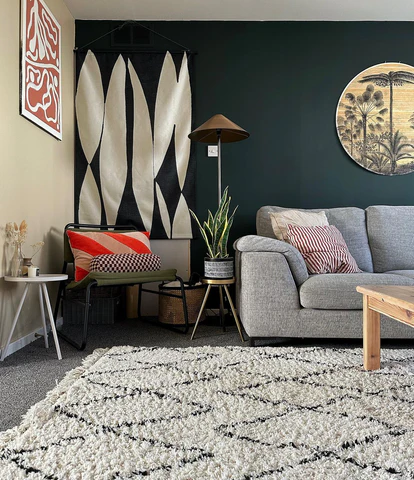When it comes to interior design, carpets and rugs are essential elements that can dramatically transform a room’s atmosphere. They add warmth, comfort, and character to any space while also serving functional purposes, such as reducing noise and protecting flooring. With a wide range of styles, materials, and patterns available, there’s a perfect carpet or rug to suit every taste and need. In this blog, we’ll explore the different types of carpets and rugs, tips for choosing the right one, and maintenance practices to keep them looking fresh for years.
1. Types of Carpets & Rugs
a. Area Rugs Area rugs are versatile pieces that can be placed anywhere in your home to add color and texture. They’re perfect for creating defined spaces in open-concept homes. Whether you want a cozy feel in the living room or a focal point in the dining room, area rugs come in various shapes and sizes to suit your needs.
b. Persian Rugs Persian rugs are known for their intricate designs and craftsmanship. These hand-knotted rugs originate from Iran and are often made with high-quality wool or silk. Persian rugs are prized for their durability and can become cherished heirlooms that add elegance and sophistication to any room.
c. Shag Carpets Shag carpets are famous for their long, plush fibers that create a soft and luxurious feel underfoot. Popular in the 1970s, shag carpets have made a comeback in modern design, often appearing in cozy spaces such as bedrooms or family rooms.
d. Oriental Rugs Like Persian rugs, Oriental rugs are crafted with detailed patterns and rich colors. However, Oriental rugs can come from various regions in Asia, including China, India, and Turkey. These rugs are typically handmade and can add a unique and timeless touch to your space.
e. Natural Fiber Rugs Natural fiber rugs, like jute, sisal, and seagrass, are eco-friendly options that bring earthy textures into your home. These rugs are durable and ideal for high-traffic areas, such as hallways or entryways. They work well in spaces with a rustic or bohemian aesthetic.
2. Benefits of Using Carpets & Rugs
a. Comfort and Warmth One of the primary reasons people choose carpets and rugs is for the added comfort they provide. They create a soft surface that feels warm underfoot, especially during colder months. For families with children, carpets and rugs are also a safer surface for play, offering some cushioning against falls.
b. Noise Reduction Carpets and rugs help absorb sound, making them excellent choices for rooms where noise levels might otherwise be high, like living rooms or offices. By reducing echo and dampening footsteps, they make your home feel quieter and more peaceful.
c. Improved Indoor Air Quality Believe it or not, carpets can actually improve indoor air quality. They act as filters, trapping dust, allergens, and particles within their fibers until they’re vacuumed away. However, this is only effective if the carpet or rug is cleaned regularly.
d. Enhanced Aesthetic Appeal With an endless array of colors, patterns, and textures available, carpets and rugs can significantly elevate the aesthetic of a room. Whether you want to create a bold statement or add subtle texture, they offer an easy way to personalize your space.
e. Protection for Flooring Carpets and rugs protect the underlying flooring from wear and tear, especially in high-traffic areas. Hardwood floors and tiles can be prone to scratches, so placing a rug or carpet over them extends their lifespan.
3. How to Choose the Right Carpet or Rug
a. Consider Your Lifestyle When selecting a carpet or rug, it’s essential to think about your lifestyle and the specific needs of your household. For instance, if you have children or pets, you may want to choose a stain-resistant and durable material, like nylon or polyester.
b. Size Matters The size of the carpet or rug should complement the layout of your room. In the living room, a large area rug that fits under the sofa and coffee table creates a cohesive look. In bedrooms, a rug placed under the bed with some exposed edges gives the room a balanced appearance.
c. Style and Color Consider the existing color palette and décor style of your room. If you’re looking to add color, choose a rug with bold hues or patterns. For a more minimalist look, neutral tones in solid colors or subtle patterns work well. Remember, rugs can be used to either harmonize with or contrast existing décor.
d. Material The material of the carpet or rug affects its look, feel, and durability. Wool is soft, resilient, and warm, while synthetic fibers like nylon and polyester are often more affordable and resistant to stains. Natural fibers, such as jute and sisal, add texture but may not be as comfortable underfoot.
e. Maintenance If you’re looking for a low-maintenance option, go for synthetic fibers that are easy to clean. For high-traffic areas, consider rugs with darker colors or patterns that hide stains and dirt more effectively.
4. Carpet & Rug Maintenance Tips
a. Regular Vacuuming Vacuuming your carpets and rugs at least once a week helps to remove dust, dirt, and allergens. Make sure to use the appropriate vacuum settings for different types of fibers.
b. Spot Cleaning In case of spills, act quickly to prevent stains from setting in. Blot (don’t rub) the spill with a clean cloth, and use a mild detergent or a specialized carpet cleaner for tougher stains. Be cautious with chemical cleaners, especially on natural fibers like wool.
c. Rotate Your Rugs To ensure even wear, rotate your rugs every few months. This is especially important for rugs in high-traffic areas, as it prevents certain sections from becoming overly worn.
d. Professional Cleaning Consider having your carpets and rugs professionally cleaned every 12-18 months. Professional cleaning removes deep-seated dirt and grime, which can’t be reached by a regular vacuum. For delicate materials like wool or silk, professional cleaning is essential to prevent damage.
e. Use Rug Pads Using a rug pad under your rug can prevent slipping and add extra cushioning. Rug pads also help protect your flooring and extend the life of your rug by reducing friction and wear.
5. Trends in Carpets & Rugs
a. Bold Patterns and Colors Modern design trends are embracing bold patterns, geometric shapes, and vibrant colors in carpets and rugs. A statement rug can become the focal point of any room, adding personality and visual interest.
b. Sustainable Materials With the growing emphasis on sustainability, many homeowners are opting for eco-friendly rugs made from natural fibers or recycled materials. This trend reflects a commitment to environmentally conscious living.
c. Layered Rugs Layering rugs is a trendy design technique that adds depth and texture to a space. You can layer a smaller, colorful rug over a larger neutral one to create an eclectic look.
d. Minimalist and Neutral Tones For those who prefer a calm and uncluttered aesthetic, minimalist rugs in neutral tones, such as beige, gray, and ivory, remain popular. These rugs provide elegance without overpowering the rest of the décor.
Conclusion
Carpets and rugs are more than just floor coverings; they’re essential elements of interior design that bring warmth, comfort, and style to your home. Whether you’re drawn to the elegance of Persian rugs or the simplicity of natural fiber rugs, choosing the right carpet or rug can significantly enhance your space. With proper care and maintenance, these pieces can last for many years, providing both beauty and function in your home.










